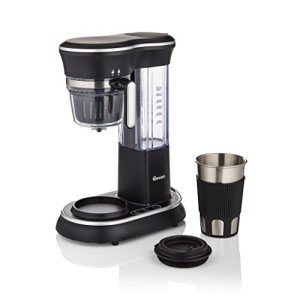10 Websites To Help You To Become A Proficient In Whole Bean Coffee Machine
The Ultimate Guide to Whole Bean Coffee Machines
In an age where coffee lovers have become progressively critical, the choice of a coffee machine has actually become more pivotal than ever. Whole bean coffee machines have actually emerged as a preferred amongst major coffee drinkers, enabling them to draw out the best flavors from coffee beans. This short article dives into the intricacies of whole bean coffee machines, exploring their features, benefits, and considerations for the passionate coffee enthusiast.
What is a Whole Bean Coffee Machine?
A whole bean coffee machine is developed to grind coffee beans right before brewing, ensuring optimum freshness and taste extraction. Unlike standard coffee makers that count on pre-ground coffee, these machines integrate a mill, which enables the user to select the grind size matched to their brewing method, from espresso to French press.
Advantages of Whole Bean Coffee Machines
Freshness: The primary advantage of using whole beans is that they retain their flavor longer than pre-ground coffee. Grinding right before brewing preserves the fragrant oils that add to the overall flavor profile.
Modification: Many whole bean machines permit users to change grind settings, water temperature, and developing time to develop a tailored cup of coffee that fulfills specific choices.
Quality Control: Whole bean coffee machines empower users to pick top quality beans from various sources, making it much easier to explore unique flavor profiles.
Versatility: These machines accommodate various developing methods, making it possible for users to craft espresso, drip coffee, or specialized brews with ease.
Convenience: Integrated mills streamline the coffee-making process, reducing the need for extra devices and lessening cleanup.
Key Features to Consider
When choosing a whole bean coffee machine, several functions must be considered:
Grinder Type:
- Burr vs. Blade: Burr grinders offer a more consistent grind, which is vital for consistency in flavor, whereas blade grinders tend to produce unequal grinds.
Brew Method Compatibility: Ensure the machine can accommodate the developing method preferred (e.g., espresso, pour-over, French press).
Capability: Consider the hopper size for holding coffee beans; bigger capabilities imply less regular refilling.
User Interface: Look for machines with instinctive controls, enabling users of all ability levels to run them easily.
Maintenance: Machines that are easy to clean and preserve will save time and ensure the durability of the device.
Product Quality: Stainless steel and top-quality plastic offer toughness, while machines with glass components tend to be less resilient.
Popular Whole Bean Coffee Machines
Brand
Design
Grinder Type
Capacity (Cups)
Features
Cost Range (₤)
Breville
BES870XL Barista Express
Burr
8
Espresso machine, steam wand
600 – 700
De'Longhi
EC702
Pump
10
Dual boiler system, stainless-steel
300 – 400
Cuisinart
DCC-3200P1
Blade
14
24-hour programmable, drip coffee
50 – 100
Rancilio
Silvia
Burr
2
Expert feel, steam power
700 – 800
Hamilton Beach
49980A
Blended
2
Single-serve, flexible brewing
30 – 50
How to Make one of the most Out of Your Whole Bean Coffee Machine
To accomplish the best results with a whole bean coffee machine, think about the following ideas:
Quality Beans: Always choose top quality, fresh beans that match your taste.
Grind Size: Adjust the grind size based upon the developing method. Finer grinds are proper for espresso, while coarser grinds work better for French press.
Developing Temperature: Water temperature level ought to generally be between 195 ° F and 205 ° F (90 ° C -96 ° C) for optimal extraction.
Water Quality: Use filtered water for the best flavor and to prolong the machine's life-span.
Maintenance Schedule: Regularly tidy the mill and machine to prevent residue accumulation and guarantee consistent performance.
Frequently Asked Questions about Whole Bean Coffee Machines
1. Is a whole bean coffee machine worth the financial investment?
Yes, if you value the freshness and taste of your coffee, investing in a whole bean coffee machine is helpful. It permits a richer and more aromatic cup of coffee compared to pre-ground options.
2. How do I tidy my whole bean coffee machine?
A lot of machines include cleaning guidelines. Generally, you'll need to remove the grinder, tidy the hopper, and run a cleaning cycle with water. Usage brushes particularly created for this function.
3. Can Best Bean Cup Coffee Machine utilize pre-ground coffee in a whole bean machine?
The majority of whole bean coffee machines are particularly designed for whole beans; nevertheless, some might permit you to utilize pre-ground coffee. Seek advice from the maker's guidelines.
4. What is the very best grind size for espresso?
A fine grind is usually preferred for espresso. Nevertheless, experimentation can assist find the best grind size that matches your taste preferences.
5. How typically should I change the coffee beans?
For ideal freshness, it is encouraged to use coffee beans within two weeks of opening after they have actually been roasted. Store them in an airtight container away from light and moisture.
A whole bean coffee machine can elevate the coffee experience, supplying freshness, customization, and superior flavor. With numerous alternatives readily available, prospective purchasers can find a machine that fits their lifestyle and coffee preferences. By considering the previously mentioned functions, ideas for optimization, and preserving a consistent cleaning regimen, users can enjoy every cup of newly brewed, fragrant coffee for several years to come. Whether for personal use or amusing guests, investing in a whole bean coffee machine is a step towards coffee excellence.
